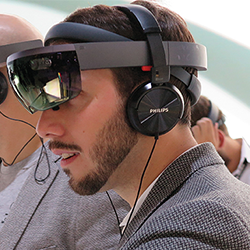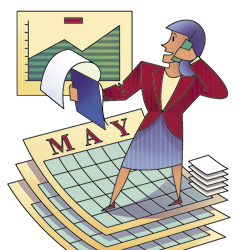|
technology
Virtual Solutions to Real Problems
Three companies with services as disparate as construction and health care take augmented- and virtual-reality activations beyond gimmicky traffic builders and unleash the technology's vast potential for storytelling, brand building, and overcoming familiar exhibit-marketing obstacles. By Ben Barclay
Athenahealth inc. photos: Genuine Interactive LLC; At&T inc. photo: DroneHub Media; JLG industries inc. photos: Godfrey advertising inc. and JLG Industries, Inc.

Athenahealth Inc. uses augmented reality to turn an undersized exhibit in a sketchy location into a sky-high success. Leading up to the 2018 Healthcare Information and Management Systems Society Conference (HIMSS), Athenahealth Inc. asked Genuine Interactive LLC, Jack Morton Worldwide Inc.'s technology agency, to help elevate its story above the noise of larger competitors. The stakes couldn't have been higher for the midsized electronic health records and cloud-based management solutions provider, as HIMSS attracts 45,000 information-technology experts within the health-care industry. When developing a strategy, Genuine decided to build on Athenahealth's core proposition of helping hospitals manage the back-office paperwork to free up more time for their health-care providers. "We decided to focus on the issue of paper," says Greg Knoff, vice president at Genuine. "Paper is the old way of tracking health-care information – it's messy, disconnected, and costly." And what could be a better visual metaphor for the headaches plaguing the industry than a prodigious pile of paper? But not even all the reams of Dunder Mifflin would make the desired visual impact. To exacerbate the situation, Athenahealth's booth was significantly smaller than many of its competitors' stands and tucked away in the far corner of the hall near the restrooms. No matter how many vitamins the company took, it couldn't grow its footprint. But since augmented reality isn't bound by square footage, the company could extend its presence upward with an infusion of AR magic. So Genuine created a 20-foot, 2.5-ton, Dr.-Seuss-eat-your-heart-out sculpture of what looked like several undulating towers of plain white paper. The artful installation consisted of nearly 10,000 PVC sheets that were hand glued to an aluminum superstructure. However, the sculpture's pièce de résistance was more than a dozen sheets that were heated, curved by hand, and suspended above the stacks, appearing to be carried away on a breeze. But this was more than a visually dazzling delight, as the sculpture also served as a canvas for an AR activation that furthered Athenahealth's value-proposition story. 
Attendees' augmented-reality experience began once they picked up one of three iPads situated in front of Athenahealth Inc.'s towering installation. A custom application mapped the sculpture and took users on a four-part AR engagement.
The story continued with a graphic overlay claiming "We deliver on quality, not just quantity," while the bottom banner shifted to explain how the IT company handles the busywork on doctors' behalf. The first experience ended with a testimonial from a health professional, and users could opt to have more info emailed to them. The three additional AR animations followed the same formula: problem, solution, and call to action. All told, the four-part experience lasted about three minutes, ensuring Athenahealth didn't bury attendees in another time suck. By the end of the three-day show, the sculpture's visual grandeur lured thousands of attendees into Athenahealth's booth, where several hundred interacted with the AR activation and took in the company's narrative about how it's making health care's mile-long paper trails a thing of the past. Even better, several industry influencers posted about the installation on social media, providing Athenahealth a healthy boost in brand awareness. 

AT&T Inc.'s Business brand makes its intangible telecommunications network tangible via augmented reality. Cybercommunication between data-heavy networks that are often hundreds of miles apart can consume precious time, sometimes at the cost of millions of dollars – or even lives. AT&T Inc. is working to improve this intrinsic inefficiency with what it calls Edge-to-Edge intelligence. Take driverless vehicles, which need to make hundreds if not thousands of calculations per second. The lag time involved in the typical communication between the in-car computer and a distant network makes the safe operation of such a car nearly impossible. The Edge platform, however, lets the vehicle's onboard computer make those key decisions nearly instantaneous and rely on distant networks for less time-sensitive functions such as map updates. That may sound complex, because it is. Equally as challenging, though, was making this nebulous concept more tangible to attendees of AT&T Business' second annual Summit event in Dallas, to which the company invited 1,500 customers and prospects from a range of industries. So AT&T asked the experiential-marketing firm Impact XM to deliver an exhibit capable of doing just that. The resulting space was less of a booth and more of a series of pods splashed across a roughly 100-by-100-foot space in which each of six 35-foot circular areas represented a specific topic: manufacturing, health care, emergency response, retail, finance, and smart cities. At each pod, AT&T used myriad engagement strategies, ranging from robots to simulators, to tout its industry-specific solutions. However, at three of them – Transforming Manufacturing, FirstNet, and Transforming Healthcare – the communication Goliath and Impact XM tapped the power of augmented reality to make AT&T's virtual network fathomable to even the most tech-challenged attendee. "With each of these pods, we walked attendees through a digital transformation scenario showing how AT&T's Edge-to-Edge technology was going to be changing that industry," explains Paul Spadafora, senior creative director for Impact XM. The crown jewel of each pod was a static, industry-specific central element that anchored its AR story. To deliver that narrative, each pod was equipped with two to four Microsoft HoloLens headsets. Titled FirstNet, the name of the AT&T-built emergency-response network, the first-responders pod featured an emergency scenario centered around a formidable black Chevrolet Tahoe PPV (police pursuit vehicle). A mannequin outfitted in a police uniform and body camera stood next to the vehicle while a static drone was suspended overhead. Rounding out the scene was an 8-foot-tall wall shaped like a command-center van with a large LED screen that looped videos of emergency responders in action. After visitors entered the space and donned HoloLenses, a voiceover and series of animations explained that FirstNet connected emergency responders to a network dedicated to public safety. The scenario started with a dispatcher calling all units to respond to a missing-child bulletin. A virtual street map of the lost child's area appeared with icons indicating several nearby live-feed webcams, on which users air-tapped to watch the cameras scanning crowds using facial-recognition software. At last, one of the cameras flashed a confirmation that the child had been recognized and relayed the location to the mannequin, representing the officer nearest to the location. That responder located the child, took a photograph using a body camera, and obtained a positive ID. Instead of having to drive back to the station to file the report, the AR graphics and narration explained that a report would be delivered using the officer's mobile router. The experience ended with a visualization of how all the Edge elements used in the scenario are connected via AT&T's cloud network. The AR activation that truly dazzled attendees, however, was the Transforming Healthcare pod, which presented a deceptively simple operating room of the future centered around an empty OR table on a low dais. Following the introduction, a holographic patient appeared on the table with a surgeon beside him, and attendees were thrust into the middle of an emergency heart surgery, during which they could rotate and dissect a voluminous 3-D heart. As the surgery came to a close, multiple video screens appeared above the patient depicting several worried people accessing mobile devices in locations ranging from the waiting room to the street. A closeup of one screen indicated "surgery complete," and relief registered across the concerned faces. Like the other AR experiences, the activation ended with a representation of the scenario's interconnected technologies. As immersive as the AR stories were, AT&T and Impact XM's deployment of the activations was equally impressive. Each experience lasted less than three minutes to keep the flow of traffic above the speed of a dial-up modem. Facilitators remained nearby to assist needful attendees as well as to supplement the narratives with deeper conversations about the intricacies of AT&T's network. The combination of fantastic storytelling and story doing around a core industry-specific element moved the activations light-years ahead of the gimmicky AR experiences often found in exhibit halls. And it demonstrated how the technology, when used to its fullest, can deliver engaging content that helps attendees connect the dots. 

JLG Industries Inc. elevates its standing in the construction industry by getting a lift from virtual reality. At shows featuring massive equipment, it can be tempting for exhibitors to rely on machinery to do the heavy lifting. But that approach is not without limitations, especially for a company such as JLG Industries Inc., which manufactures access equipment such as aerial work platforms and boom lifts. For one, other companies haul in the sort of heart-palpitating machinery that causes grown men to swoon, e.g., massive bulldozers, backhoes, and cranes. JLG's telescoping platforms don't quite pack the same punch. The other challenge is that companies can't allow attendees to take the equipment for a test-run about the town, reducing the colossi to little more than eye candy. Besides, JLG doesn't want to be seen as simply another equipment manufacturer, but rather an industry innovator. To overcome its obstacles and reach its lofty goals at ConExpo-Con/Agg in Las Vegas, JLG was going to need more than a scissor lift. So the firm reached out to Godfrey Advertising Inc., a PA-based marketing agency, to develop an inventive strategy that would emphasize the company's future-forward attitude. "We were looking to help JLG be bold and to disrupt the idea of what an equipment manufacturer might be," says Bridey Orth, creative director at Godfrey. To sell the story that the brand was something more than a nuts-and-bolts operation and to allow attendees a hands-on experience with JLG's equipment, the manufacturer and Godfrey decided to rely, in part, on a pair of activations that put attendees in the driver's seat – at least virtually. JLG had a number of exhibit spaces at the show, including an outdoor area to showcase its aerial equipment, a main booth adjacent to the equipment yard, and a smaller exhibit inside the ConExpo Tech Experience pavilion, a venue dedicated to highlighting the latest industry technologies. Inside the pavilion, JLG set up its VR Theater to demonstrate the company's new No Touch Enhanced Detection System (EDS) that uses infrared sensors to stop lifts and booms from contacting overhead structures. To offer a more realistic experience of operating a lift's control cab, the space traded traditional theater seating for four waist-high handrails. The railings had a total of six VR headsets tethered to them, but more importantly, they provided a stabilizing handhold to ensure users avoided the sort of VR-induced falls that make great fodder for so many YouTube videos. Using Google Daydream VR headsets and Pixel phones, Godfrey crafted a two-minute experience inside a virtual airport hangar. When users donned the headsets, they were immersed in the hangar and placed in one of JLG's scissor lifts zooming toward a commercial airliner. When it arrived at the plane, the scissor lift began its ascent to the aircraft's wing. As the platform neared the virtual assemblage, the EDS' infrared detectors automatically slowed, stopped, and then reversed the ascent, giving users a virtual look at how JLG's new technology can help companies avoid costly calamities. 
JLG Industries Inc.'s exhibit at ConExpo-Con/Agg allowed attendees to take a ride in one of the company's scissor lifts via virtual reality.
One common exhibitor complaint about VR is that it excludes anyone not wearing a headset, limiting its ability to engage droves of attendees. To sidestep that pothole, JLG mounted a large monitor adjacent to each platform that mirrored what the user was seeing in the headset. A company rep stood nearby and explained to bystanders just what they were witnessing on the flatscreen. "All of our objectives were achieved through the narrative we created," says Jennifer Stiansen, director of marketing at JLG. "It showed our audience we are not just the machines we make. We have all these other things to offer, and we did it in an engaging way." By providing show-goers firsthand experiences with its technologies despite being unable to allow attendees to lift off in its actual lifts, JLG's activations had visitors clamoring to climb into its virtual work environments. And in the process, the aerial equipment manufacturer managed to rise above the competition, position itself as a top-tier industry innovator, and prove that when it comes to meaningful and creative VR activations, the sky's the limit.
|
|
|
||||||||||||||||||||||||||||
|
|
||||||||||||||||||||||||||||
|
TOPICS Measurement & Budgeting Planning & Execution Marketing & Promotion Events & Venues Personal & Career Exhibits & Experiences International Exhibiting Resources for Rookies Research & Resources |
MAGAZINE Subscribe Today! Renew Subscription Update Address Digital Downloads Newsletters Advertise |
FIND-IT Exhibit & Display Producers Products & Services Supplier to Supplier All Companies Compare Get Listed |
EXHIBITORLIVE Sessions Certification Exhibit Hall Exhibit at the Show Registration |
ETRAK Sessions Certification F.A.Q. Registration |
EDUCATION WEEK Overview Sessions Hotel Registration |
CERTIFICATION The Program Steps to Certification Faculty and Staff Enroll in CTSM Submit Quiz Answers My CTSM |
AWARDS Sizzle Awards Exhibit Design Awards Portable/Modular Awards Corporate Event Awards Centers of Excellence |
NEWS Associations/Press Awards Company News International New Products People Shows & Events Venues & Destinations EXHIBITOR News |
||||||||||||||||||||
|
||||||||||||||||||||||||||||






